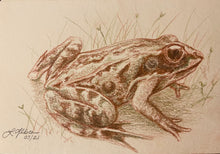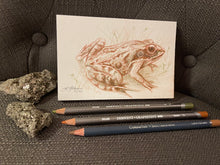Wood Frog (Lithobates sylvaticus) on cold pressed cotton paper with Graphitint pencils - Ivy, Chestnut & Cafe au lait. (4 x 6”)
These guys are found across Canada in sensitive wetlands. identifiable with their distinct chirping calls echoing into the night around July and August and dark mask-like bands across their eyes.
Another fun fact about Wood Frogs is their ability to freeze near solid in the winter time:
‘Similar to other northern frogs that enter dormancy close to the surface in soil and/or leaf litter, wood frogs can tolerate the freezing of their blood and other tissues. Urea is accumulated in tissues in preparation for overwintering, and liver glycogen is converted in large quantities to glucose in response to internal ice formation. Both urea and glucose act as cryoprotectants to limit the amount of ice that forms and to reduce osmotic shrinkage of cells.
Frogs can survive many freeze/thaw events during winter if no more than about 65% of the total body water freezes. Wood frogs have a series of seven amino acid substitutions within their body’s enzymes that allows them to function at lower temperatures relative to less cold-tolerant species.’
Kenneth B. Storey (1997). "Organic solutes in freezing tolerance". Comparative Biochemistry and Physiology A. 117 (3): 319–326. doi:10.1016/s0300-9629(96)00270-8. PMID 9172388.






